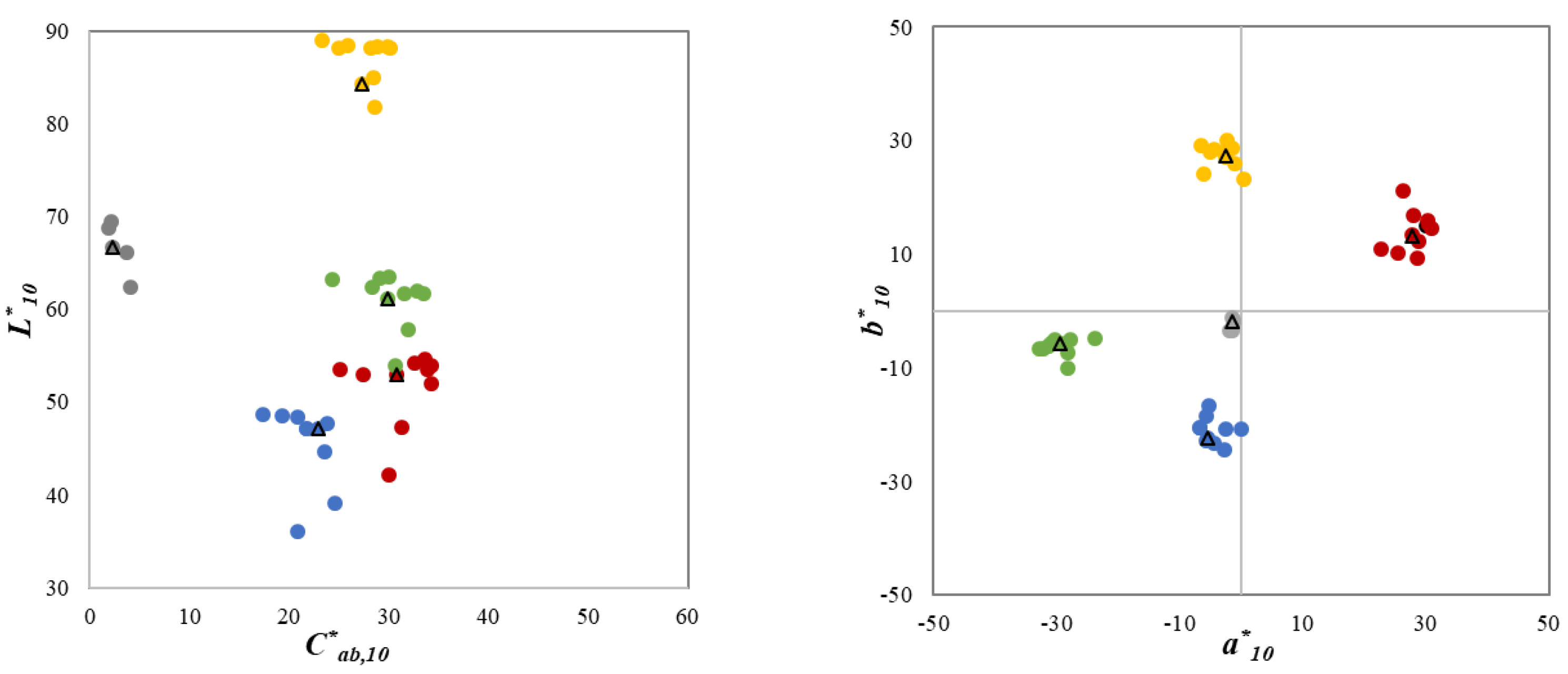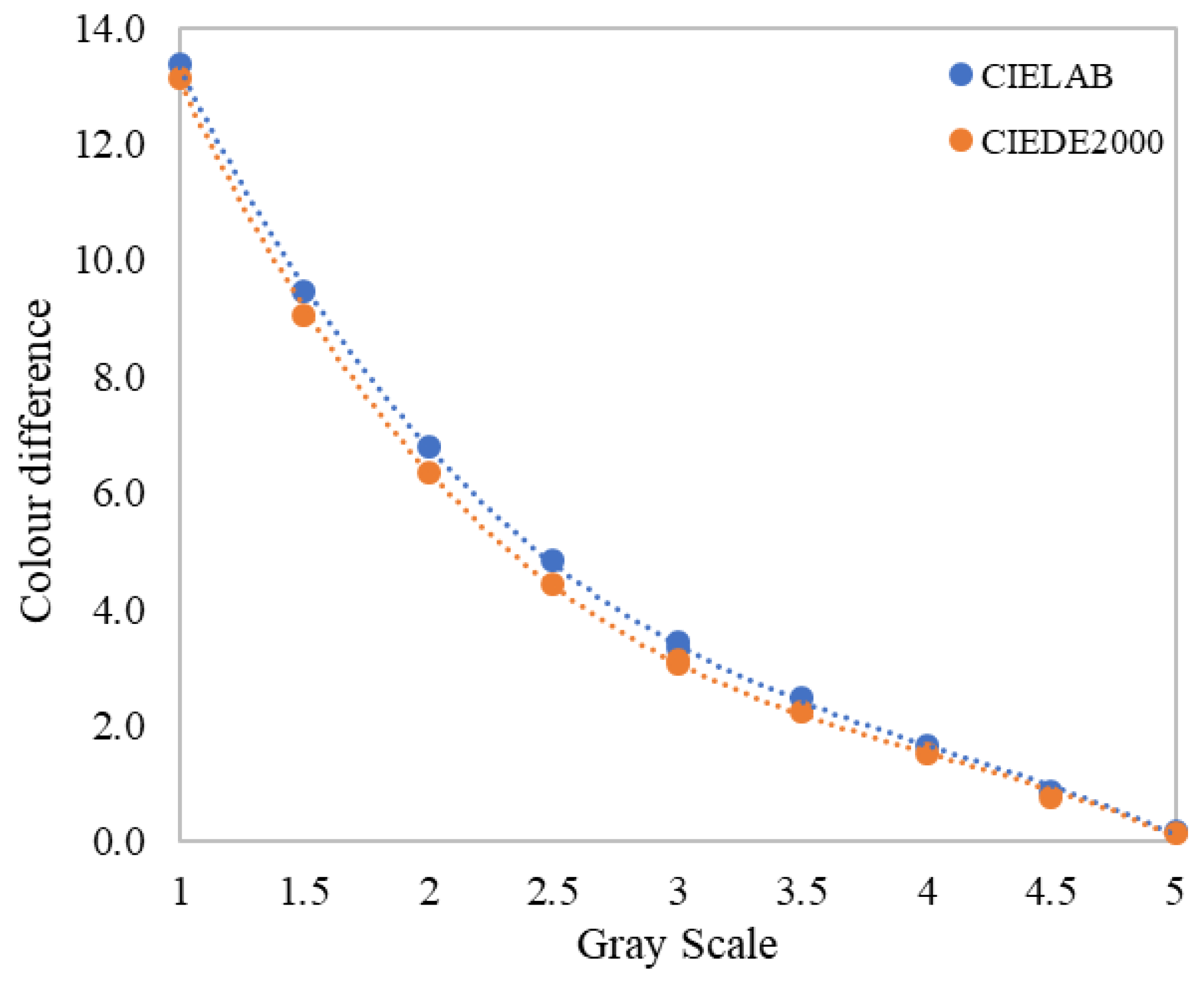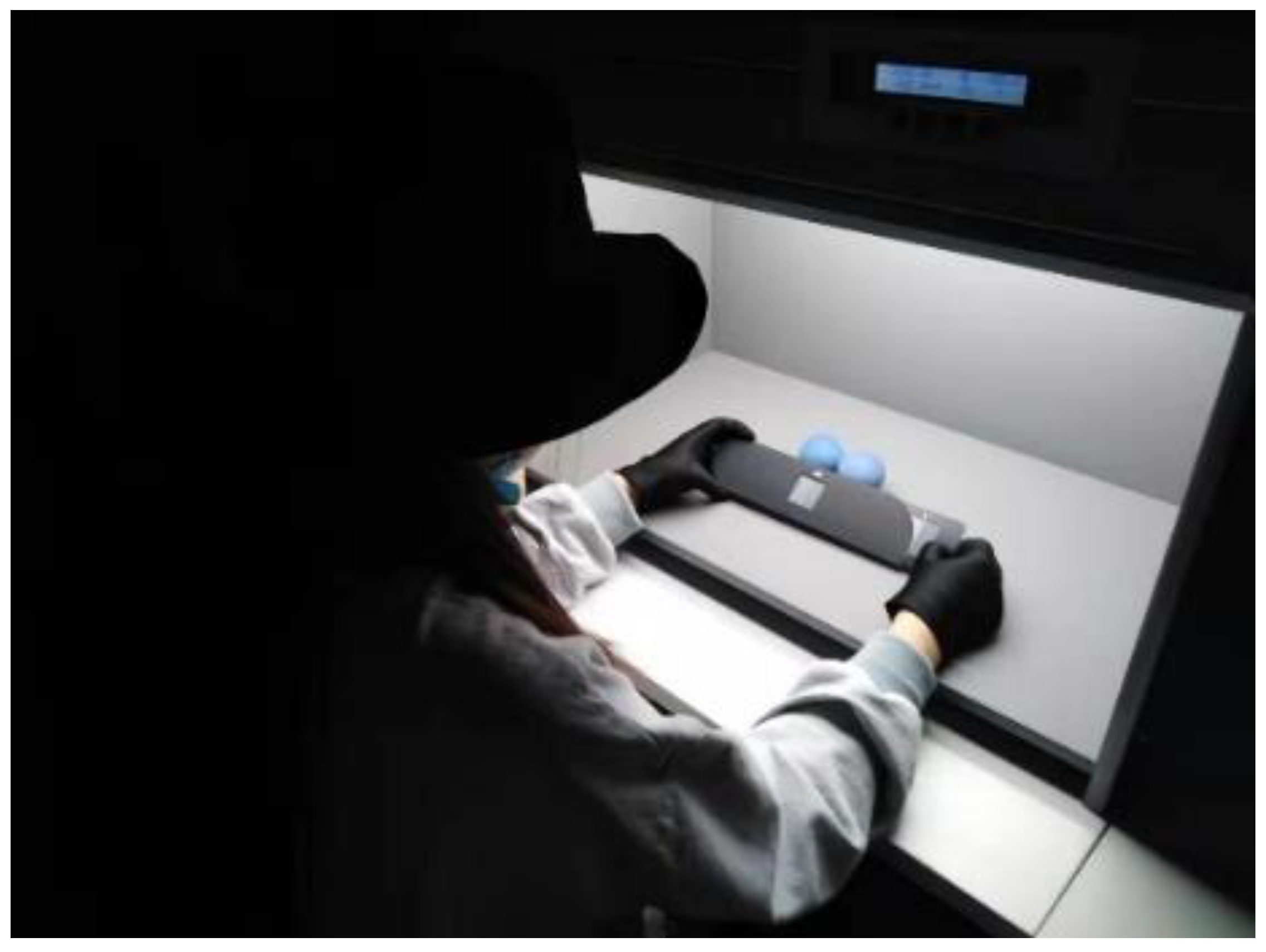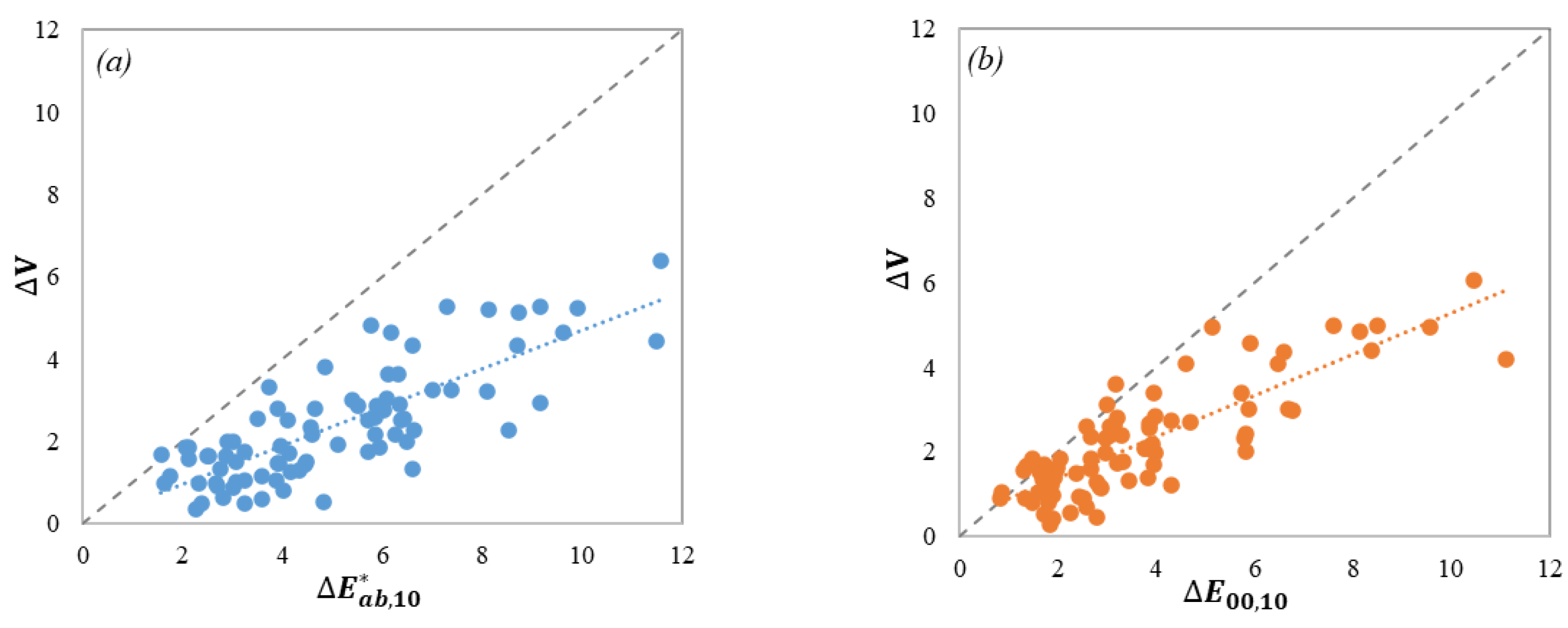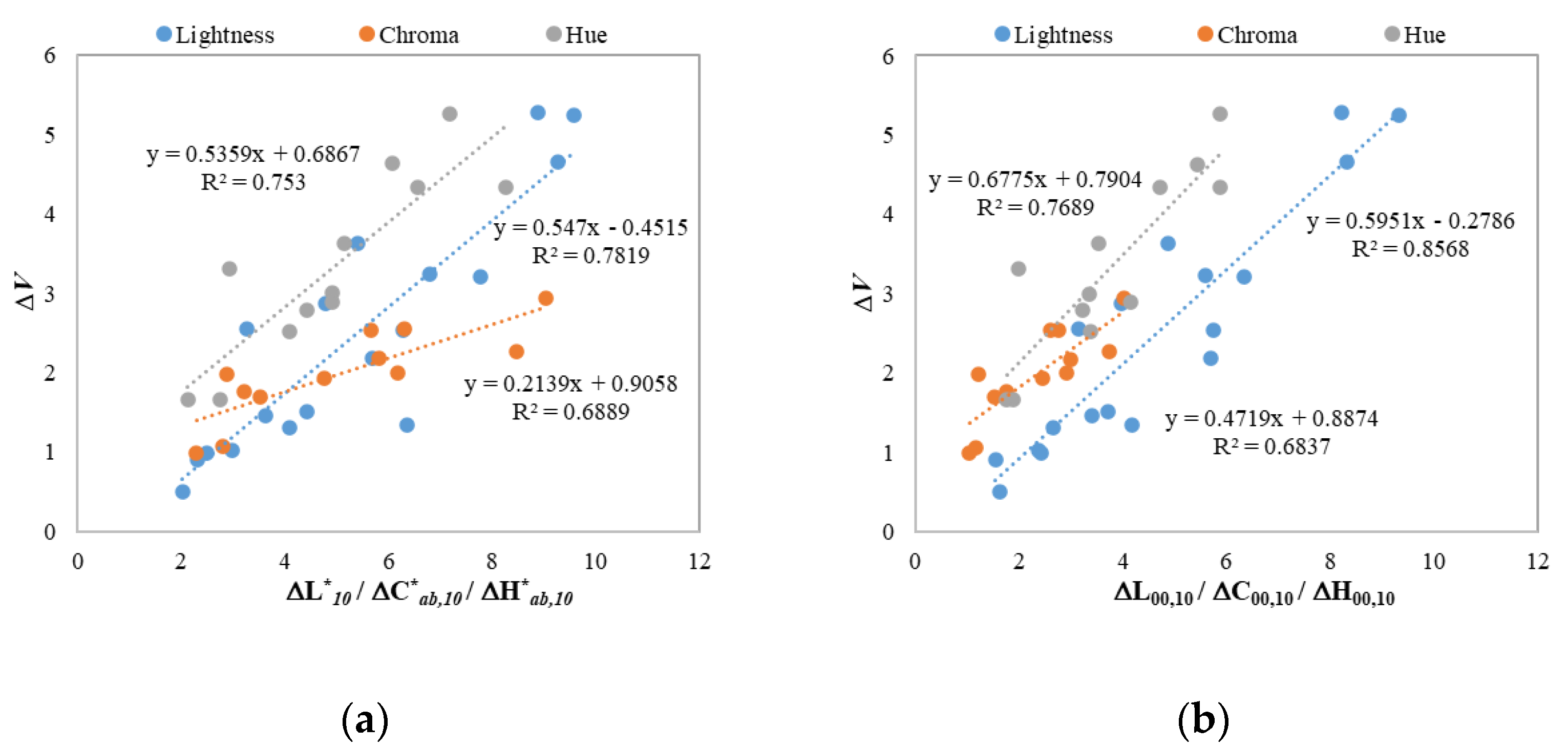1. Introduction
With the rapid development of various 3D printing technologies, it has become more and more popular in recent years to produce colored solid objects using a 3D color printer because of its advantages of saving both time and money [
1]. This method directly interconnects with advanced manufacturing techniques and customization with excellent accuracy and many applications have been involved, such as art and design practice [
2], manufacture of soft tissue prostheses [
3], dentistry [
4], food [
5], etc. Despite the advances in production technologies, faithfully reproducing the color appearance of 3D objects remains a challenge because it requires knowledge of 3D metrology, color modeling, human perception, and 3D printing [
6]. The International Commission on Illumination (CIE) has listed the reproduction and measurement of 3D objects as one of the top priority topics in its current research strategy [
7]. Furthermore, the CIE Technical Committee 8–17 has been established to develop methods for evaluating the color differences between 3D objects.
For measuring object colors, a CIELAB color space based on CIE XYZ tristimulus values was recommended by CIE [
8] and the associated CIELAB color-difference formula has been widely used to quantify the perceived color difference between a pair of colored samples. Due to its visual non-uniformity, the CIEDE2000 color-difference formula was developed to improve the correlation between the computed and perceived color differences [
9]. Currently, the CIEDE2000 color-difference formula is jointly recommended as a standard by the CIE and the International Organization for Standardization (ISO) [
10].
The development of current color-difference formulas, however, has always been based on flat colored samples [
11,
12,
13,
14]. In contrast to a 2D sample, a 3D printed object has a non-uniform surface and it is more complicated for the human visual system to process color information, especially considering that the color appearance of 3D objects is probably affected by the 3D shape, gloss, and different lighting conditions [
15,
16,
17]. It has been reported that color-difference formulas predict the lightness difference contribution to the total color difference in different ways for spherical and flat samples [
17]. To understand the basic visual perception of colored 3D objects, Hung et al. conducted a series of psychophysical experiments to quantify the visual color differences of 3D objects using a 7-step gray scale [
18] and it was found that chroma differences for high chroma or dark colors were not easy to visually assess. The authors suggested that in the color-difference formula, the measured lightness and chroma values must be further scaled to fit the visual data.
Considering that the
parametric factor in CIEDE2000 is recommended to have a value of 1 under reference conditions, whereas for the textile industry
= 2 was necessary to allow for the associated texture effect, the parametric factors in color-difference formulas have been used to improve the prediction performance in different applications. Liu et al. optimized the
factor in the color-difference formulas CIELAB, CIEDE2000, CIE94, and CMC for digital images [
19], and the results showed that CIEDE2000 (2.3:1) performed the best. Mirjalili et al. [
13] concluded that optimizing the lightness parametric factor,
, resulted in an improvement in the performance of the CIEDE2000 formula.
In addition to modifying parametric factors, Huang et al. proposed that color-difference formulas modified by a power function provided better agreement with visually perceived color differences [
11]. Jiang et al. found that using an additional power function with an exponent of 0.55 achieved an improvement (
STRESS values in a range from 23.0 to 26.3) in the prediction of 150 pairs of 3D-printed samples compared to the results found using the original formulas (
STRESS values in a range from 30.0 to 37.9) [
17]. However, the authors suggested that the exponent of 0.55 probably over-fitted the experimental data. Moreover, Pan et al. optimized the exponents in the power functions applied to the color-difference formulas and reported that the addition of a power function gave better performance than optimizing the
lightness factor for the 3D spherical samples [
20].
The color difference evaluation of 3D objects has stimulated industrial and academic interest but currently, there is insufficient available color-difference data collected using 3D objects and comprehensive knowledge of the visual color perception of 3D objects is desired. In the present study, 42 pairs of spherical 3D-printed samples (Experiment I) were prepared to have predominantly lightness, chroma, or hue differences, and visual color-difference assessments were conducted to investigate the human color perception of these 3D objects in terms of the lightness, chroma, and hue dimensions. Moreover, considering the simplicity of CIELAB and the joint CIE/ISO recommendation of CIEDE2000 for industrial applications, these two color-difference formulas were tested using data derived from a further set of 40 pairs of spherical 3D-printed samples (Experiment II).
2. Materials and Methods
2.1. 3D Sample Pairs
The 5 CIE-recommended color centers: gray, red, green, yellow, and blue [
21] were used in this study to prepare 3D samples. Specifically, 5 colors with very similar chroma and hue but different lightness from the gray center and 10 colors with different lightness, chroma, or hue from each of the other four color centers were designed and the difference was within 10 units. By performing color characterization on the Stratasys J750 3D color printer, the 45 colors were printed with resins and 45 spherical samples with a diameter of 50 mm were prepared, as shown in
Figure 1.
Each sample was measured at three different points using a Konica Minolta CM-700d spectrophotometer with d:8 geometry, small aperture (SAV 3 mm), and specular component-included (SCI) mode. The measured spectral reflectance data were used to calculate the corresponding CIELAB values using the CIE 1964 standard observer under the illumination used in this study. The average measurement results of each sample are shown in
and
diagrams in
Figure 2, where the triangle symbols are approximately positioned at the ‘centers of gravity’ of the 5–10 printed samples at each of the five CIE-recommended centers, gray, red, green, yellow and blue (
Figure 1), and they represent the five samples that were considered as reference samples in Experiment II. To quantify the color homogeneity of the 3D-printed samples, the mean color difference from the mean (
MCDM) of the CIELAB units was calculated from the results of the three measurements [
17]. The measured average
MCDM value of the 45 samples was 1.77 units, which demonstrates relatively good color uniformity using 3D printing technology [
22].
One of the experimental designs, Experiment I, was intended to investigate the color difference between each sample of a 3D pair in terms of only one color attribute, that is, mainly lightness differences
, chroma differences
, or hue differences
. Thus, 9 testing pairs were produced for each of the four chromatic color centers to have predominant lightness/chroma/hue differences, such that the CIELAB lightness (or chroma or hue) difference for these pairs of samples was at least 85% of the total CIELAB color difference (see
Figure 3). For the CIE gray center, only 6 testing pairs with predominantly lightness differences were produced (note that the gray samples had very small differences in hue and chroma). Overall, there were 42 pairs of 3D samples, including 18 lightness-difference pairs (
≥ 0.85), 12 chroma-difference pairs (
≥ 0.85), and 12 hue-difference pairs (
≥ 0.85). In Experiment I, the color-difference magnitudes ranged from 2 to 9 CIELAB units and the average color difference was 5.46 CIELAB units.
The second experimental design, Experiment II, consisted of 40 pairs of spherical 3D samples with a common reference sample at each one of the five CIE color centers, shown by triangle symbols in
Figure 2. Therefore, in Experiment II nine pairs for each one of the four CIE chromatic centers and four pairs for the CIE gray center were considered. The color differences of the 40 sample pairs in Experiment II ranged from 1 to 12 CIELAB units and the average color difference was 4.58 CIELAB units.
A total of 82 pairs of 3D samples were used in the visual experiments to test the performance of two color-difference formulas. Specifically, Experiment I aimed to investigate the visual perception of 3D samples in terms of lightness, chroma, and hue differences, the data to be used to optimize the color-difference formulas, and Experiment II was used to test the performance of the optimized formulas.
2.2. Gray-Scale Method
The gray-scale method has been widely used for visual assessment in previous studies due to its ease of use and accurate results [
13,
17,
20,
23,
24]. In the present study, the
Grey scale for assessing change in colour from the Society of Dyers and Colourists (SDC), following ISO 105-A02 [
25], was used in the psychophysical experiments. This scale consists of 9 pairs of non-glossy neutral gray colored chips, with grades of 1, 1.5, 2, 2.5, 3, 3.5, 4, 4.5, and 5. The reflectance of each gray chip was measured using a CM700d spectrophotometer with SAV 3 mm and SCI, and the color difference between each pair of chips was calculated for the CIE1964 standard observer under the illumination used in the visual experiments.
Figure 4 plots the CIELAB and CIEDE2000 color-difference values for the 9 grades on the gray scale. Grade 1 has the largest color difference (13.36
or 13.13
) and grade 5 has almost no color difference (0.18
or 0.16
). It can be observed in
Figure 4 that the color-difference values calculated using the CIEDE2000 formula were slightly smaller than those of CIELAB, but the difference is not large for each grade because the color differences in the gray scale are predominantly caused by a lightness difference.
In order to quantify the relationship between the gray-scale grade values and the corresponding color differences, a third-order polynomial regression was used [
24]. The fitted formulas for CIELAB and CIEDE2000 color-difference units are expressed in Equations (1) and (2), with
R2 values of 0.9998 and 0.9960, respectively. Since this study aimed to test and optimize the CIELAB and CIEDE2000 formulas, Equations (1) and (2) were used separately to transform the gray-scale grades (
GS) reported by the human observers to visual color-difference values (Δ
V).
2.3. Visual Assessments
A VeriVide viewing cabinet with a D65 simulator was used in the visual color-difference assessments. The relative spectral power distribution of the D65 illumination was measured using a Konica Minolta CS2000 spectroradiometer and a reference white. The measured correlated color temperature, CIE color-rendering index , and luminance at the center of the floor of the cabinet were 6519 K, 97, and 412.35 cd/m2, respectively.
The visual experiments were conducted in a dark room and human observers were asked to adapt to the dark surroundings for two minutes. Each pair of 3D samples was placed in the center of the viewing cabinet, as shown in
Figure 5. The observer’s task was to evaluate the magnitude of the color difference in the pair in comparison with the perceived color differences in the pairs of the gray scale. All the testing pairs were presented in a random order and observers were encouraged to give intermediate assessment values with one decimal between two contiguous gray pairs (e.g., 3.6 for a color difference between the pairs 3.5 and 4 but closer to 3.5 than 4). During the visual experiments, observers had a fixed viewing position with an approximate distance of 50 cm from the samples and a 45° viewing angle. Before Experiment I commenced, a pilot experiment was performed to train the observers to make the visual assessments using the gray-scale method. In Experiments I and II, each observer repeated the visual assessments of all testing pairs three times.
A panel of 15 observers (10 females and 5 males) participated in the visual experiments, with ages ranging from 25 to 29. They were postgraduate students from the University of Leeds and had normal color vision according to the Ishihara test. Most observers had little experience in color-difference evaluation. A total of 3690 assessments (82 pairs × 3 repetitions × 15 observers) were conducted to collect visual color-difference data of 3D printed spherical sample pairs during the psychophysical experiments.
2.4. Metrics for Testing Color-Difference Formulas
2.4.1. STRESS Index
The standardized residual sum of squares (
STRESS) index (Equation 3) was proposed by García et al. [
26] and adopted by CIE [
27] to test the performance of two color-difference formulas with respect to a given set of visual color-difference data:
where
,
indicates the computed color difference of the
testing pair by a color difference formula, e.g., for CIELAB, and
is the corresponding average visual color difference for the same testing pair. The
STRESS value ranges from 0 to 100, and for a perfect agreement, the
STRESS value should be zero. The larger the
STRESS value, the worse the agreement between perceived and computed color differences.
The
STRESS index was also used to compute intra- and inter-observer variability [
28]. For each observer, intra-observer variability was computed as the average of
STRESS values of each one of the 3 replications made by this observer with respect to the average result of the 3 replications, whereas inter-observer variability was computed as the
STRESS value between the average result of the 3 replications of this observer and the average results of all 15 observers. Final intra- and inter-observer variability in the experiments were defined as the average intra- and inter-observer variability
STRESS values from the 15 observers, respectively.
2.4.2. F-Test
Although
STRESS values can be used to compare the performance of two different formulas, it is not sufficient to indicate the degree of statistical significance. The
F-test was used to analyze the statistical significances between the original and optimized color-difference formulas [
26]:
For the two-tailed F-distribution with a 95% confidence level, the critical value can be found from statistical tables with the degrees of freedom, and , defined as , where is the number of sample pairs. The calculated value from Equation (4) can be compared with the confidential interval []. If the value is smaller than , it means that the optimized formula A is significantly better than the original formula B; if the value is between and 1, the optimized formula A is insignificantly better than the original formula B; otherwise, there is no improvement achieved by formula A with respect to formula B.
2.5. Optimization Methods
In CIELAB, the total color difference is defined as a Euclidean distance in terms of lightness, chroma, and hue differences between the two stimuli. Most current advanced color-difference formulas were derived by modifying the CIELAB formula [
9], following the generic Equation (5):
where
are the CIELAB metric lightness, chroma, and hue differences, respectively,
and
are the three parametric factors and weighting functions for lightness, chroma, and hue differences, respectively, and
is an interactive term between chroma and hue difference. In the CIELAB formula,
were all set as 1 and
. However, in CIEDE2000,
are three specified weighting functions,
is related to the so-called rotation term affecting the blue saturated region of color space, and
under so-called ‘reference conditions’ for most applications (
,
for textiles).
Considering that the color appearance of 3D objects may be affected by more factors than for 2D objects, it is hypothesized that values of the parametric factors in color-difference formulas should be different for these two situations. In order to improve the predictions of CIELAB and CIEDE2000 color-difference formulas for 3D printed spherical objects, three optimization methods were used in the current paper:
Method 1: Optimize with .
Method 2: Optimize both and with .
Method 3: Apply a power function and optimize the exponent (i.e., ).
The goal of the optimizations was to minimize the STRESS value between the visual results and the values calculated using a color-difference formula by using the GRG nonlinear method in Excel Solver or the fminsearch function in MATLAB.
4. Discussion
The purpose of this study was to investigate human color perception of the lightness, chroma, and hue differences of 3D spherical objects and to optimize the current CIELAB and CIEDE2000 color-difference formulas using parametric factors and visual results collected from psychophysical experiments. It was found that it is generally easier to assess the hue differences of 3D spherical objects but not the chroma differences, and the results indicated that the parametric factors related to the lightness differences, chroma differences, and hue differences in color-difference formulas should be optimized for 3D objects.
Among the three optimization methods tested, the best performance achieved for CIELAB was to optimize both the and parametric factors, and the optimal factor (1.9) is larger than the optimal factor (1.4), indicating that the original CIELAB formula predicted a larger difference for the chroma dimension than for the lightness dimension. Moreover, both optimized factors are larger than the original values of 1.0, suggesting that the difference scale should be compressed for 3D objects in the CIELAB color-difference formula. In addition, the method of optimizing only the factor gives little improvement to CIELAB, which is quite contrary to the CIEDE2000 formula.
The optimal
parametric factor for the optimized CIEDE2000 is 1.5, which is larger than the default value of 1.0, suggesting that the visual lightness difference of 3D objects is over-estimated by the original formula. Perhaps this is because the CIEDE2000 formula with
was developed based on 2D samples with homogeneous surfaces, whereas 3D objects have non-uniform surfaces and human color perception can be easily affected by other factors such as 3D shape, gloss, and shadows, etc. Similarly, in the textile industry, it is common practice to set the lightness parametric factor to 2 [
14]. However, the experimental conditions leading to this parametric correction to lightness-difference sensitivity are not yet well understood; Liu et al. proposed
= 2.3 for assessing color differences in digital images [
19], and Huertas et al. investigated the three parametric factors based on simulated random-dot textures, suggesting values which were always larger than 1.0 [
31].
In comparison to the optimization of the parametric factors, the power function had no evident improvement over the original formulas in this study. A possible reason for this is that the 3D sample pairs used in the current visual experiments had small to medium color differences ranging from 2 to 9 CIELAB units. In the study of Jiang et al. [
17], a remarkable improvement was achieved by adding a power correction in predictions of the color differences between 3D objects in a range of 25 CIELAB units, and it was reported that the color-difference magnitude had more effect on the perceived color differences of 3D objects than the sample shape or illumination. Therefore, a power function is possibly more suitable for sample pairs with magnitudes in a very large range of color differences.

